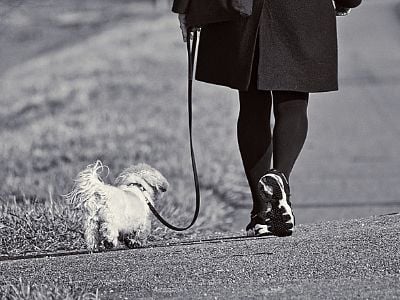Dog Training: Lead Walking
Posted on

When you go for a walk with your dog, you want to do exactly that, not be dragged along at 60mph or get constantly tangled up in the lead as he whizzes round your legs. So, let’s take a look at how we can achieve having our dogs walking nicely to heel on the lead, without any undue stress to either of you.
If you haven’t yet introduced the lead to your dog, you may like to read this earlier blog.
The Ideal Scenario
Once your dog is relaxed on the lead, bring her to sit by your side. As you slowly start to walk, give her your chosen command to instruct her to walk at heel. I often use my opposite hand to draw the dog’s attention, encourage them forwards and in the correct position – not touching the dog, just keeping their interest ahead of them. Patting the side of your leg where you want her to walk will help to draw her in and remind her where to be. Calmly praise your dog whenever she is in the correct place. If she slows down too much, an encouraging ‘come on’ usually does the trick. Maintain her interest by changing direction and adding in the odd ‘sit’ command every so often. Keep these sessions short to start with – five minutes each day is usually enough. Before you know it, it will be second nature for your dog to instinctively walk by your side.

If Your Dog Pulls On The Lead
As is the case for many aspects of dog training, ignoring the unwanted, negative behaviour is key. There are two stages to this. Initially, simply stand and wait. Ignore your dog, don’t engage with him, don’t even look at him. As soon as the lead goes slack and he calms, give quiet praise and start walking slowly. As soon as he starts to pull again, stop walking. Timing is crucial – you are teaching him consequences. Your dog is pulling because he wants to get going and get going now, on his terms. You are teaching him that the only way to get anywhere is to walk calmly by your side, on your terms.
If you haven’t the patience, or your dog is particularly resistant, feel free to skip straight to this next step.
Once your dog is starting to walk nicely and calmly – this can take several short sessions over several days – start to abruptly change direction whilst walking. For those most persistent pullers, you can even do full about-turns, without warning. This teaches your dog that they really need to be paying attention to you.
If you take a certain route on your walk every day, change it up a bit. A dog can’t pull on the lead if they don’t know where they’re going.
Related Articles:
Dog Training: Introducing The Lead

Add a comment: